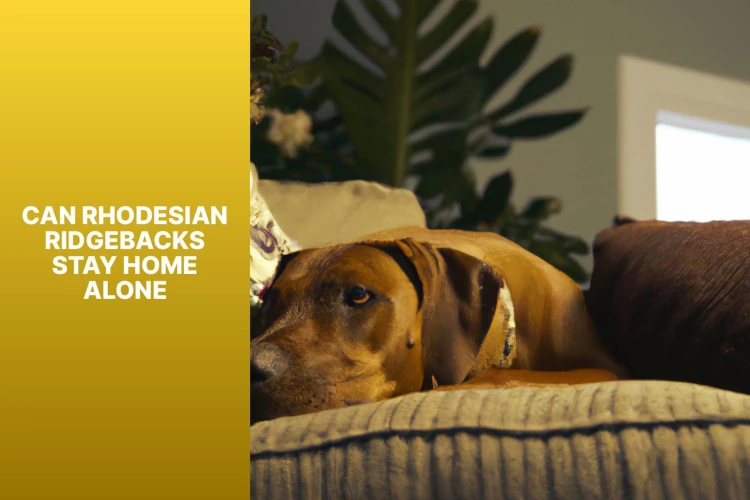Rhodesian Ridgebacks are a strong and independent breed of dog originally from Southern Africa. Known for their loyalty and protective nature, many potential owners wonder if they can leave these dogs alone for extended periods. In this article, we will explore the temperament and needs of Rhodesian Ridgebacks to determine if they can handle being home alone. Whether you are a busy professional or simply want to ensure the well-being of your pet, understanding the requirements of this breed when it comes to solitude is essential.
Table of contents
Worried about leaving your beloved Rhodesian Ridgeback home alone?
Let’s uncover the truth about whether these loyal canines can handle solitude. In this section, we’ll dive into the topic and explore the reasons behind leaving dogs home alone. Get ready to discover insights and facts that will help you make informed decisions about your furry friend’s well-being.
Reasons for Leaving Dogs Home Alone
Leaving dogs home alone is a common occurrence for pet owners. There are several reasons for leaving dogs alone, including work commitments, social activities, errands or appointments, and personal obligations.
Many people with full-time jobs cannot be home with their dogs during the day, hence the need to leave them alone. There are events or activities where dogs are not allowed, forcing owners to leave them behind. Running errands or attending appointments may also require leaving the dog at home temporarily. Unexpected commitments or emergencies can arise, making it necessary to leave the dog alone.
When leaving dogs alone, it is important to properly prepare and make them comfortable. Providing a safe and comfortable space, such as a crate or designated area, can help reduce any anxiety they may experience. Mental and physical stimulation, such as puzzle toys or leaving the radio on, can also keep them entertained. Establishing a consistent routine can provide them with a sense of security.
When leaving them alone, it is necessary to consider individual dogs’ specific needs and temperament. Some dogs may experience separation anxiety, which requires additional measures or alternative options like daycare or help from a family member or friend.
Dogs have been domesticated for thousands of years and have adapted to living in human homes. With busier lifestyles, leaving dogs home alone has become increasingly common. Understanding the reasons for leaving dogs alone and taking the necessary steps to ensure their well-being is crucial for responsible pet ownership.
Factors to Consider

Factors to consider when determining if Rhodesian Ridgebacks can stay home alone: the age and training of the dogs, the possibility of separation anxiety, and the suitability of their living conditions and home environment. Understanding these aspects is crucial in ensuring the well-being and safety of these magnificent animals while they are left on their own. Let’s explore these factors and discover how they can impact the ability of Rhodesian Ridgebacks to handle being home alone.
Age and Training of Rhodesian Ridgebacks
Several important factors must be considered when considering the age and training of Rhodesian Ridgebacks.
- Age: Rhodesian Ridgebacks go through different developmental stages as they age, affecting their ability to stay home alone. Puppies require constant supervision and should not be left alone for long periods. As they mature and become more independent, they may be able to handle shorter durations of alone time.
- Training: Proper training is essential for Rhodesian Ridgebacks to be comfortable and well-behaved when left alone. Basic obedience training, including commands like “sit” and “stay,” helps them understand boundaries and expectations. Crate training can also provide a safe and secure space when they are home alone.
- Separation Anxiety: Rhodesian Ridgebacks form close bonds with their owners and may develop separation anxiety if not properly trained and socialized. This can lead to destructive behavior and excessive vocalization when left alone. Addressing separation anxiety through training techniques and gradually increasing alone time can help alleviate this issue.
- Exercise and mental stimulation: Rhodesian Ridgebacks are an active and intelligent breed that requires plenty of physical and mental stimulation. Regular exercise, interactive toys, and puzzle games can tire them out and keep them mentally engaged, reducing any anxiety they may feel when left alone. Understanding the age and training needs of Rhodesian Ridgebacks is crucial for ensuring their well-being and comfort when left home alone.
Separation Anxiety in Rhodesian Ridgebacks
Separation anxiety in Rhodesian Ridgebacks is a prevalent issue that many owners may encounter. These dogs form strong bonds with their owners and can experience distress when left alone. Recognizing the signs of separation anxiety in Rhodesian Ridgebacks and taking appropriate steps to address it is crucial.
The signs of separation anxiety in Rhodesian Ridgebacks may encompass excessive barking, destructive behavior, house soiling, and escape attempts. These behaviors can cause stress for both the owner and the dog. To help alleviate separation anxiety, it is vital to establish a training routine that gradually teaches the dog to feel at ease when they are left alone.
One effective approach to managing separation anxiety in Rhodesian Ridgebacks is implementing a desensitization and counterconditioning program. This entails gradually increasing the time the dog spends alone and rewarding good behavior with positive reinforcement.
In addition, it is important to create a safe and comfortable space for the dog when left alone. This can be accomplished by providing mentally stimulating toys and puzzles and ensuring a cozy resting area.
Seeking guidance and support from a professional dog trainer or behaviorist can also be beneficial in managing separation anxiety in Rhodesian Ridgebacks.
Living Conditions and Home Environment
Living conditions and the home environment significantly impact Rhodesian Ridgebacks’ well-being and comfort when left alone. The space available for them to move and stretch is essential. An ideal home environment would provide a secure backyard or access to outdoor areas where they could play and explore.
Safety is another important aspect to consider. The home should be free from potential hazards that could harm the dogs. This includes securing electrical cords, toxic chemicals or plants, and small objects that can be swallowed. An environment that is dog-proof ensures their well-being.
Comfort is key in ensuring their overall well-being. It is important to provide a cozy bed or resting area, maintain optimal room temperature, and minimize loud noises or disturbances that could cause stress or anxiety for Rhodesian Ridgebacks.
To prevent boredom and promote mental stimulation while they’re alone, you can leave interactive toys, puzzles, or treat-dispensing toys, which can be beneficial. This enhances their overall well-being and prevents destructive behavior.
Rhodesian Ridgebacks are social animals and thrive on human companionship. Interacting with them before and after being away for extended periods is important, fulfilling their social needs.
By creating a suitable living environment and addressing the specific needs of Rhodesian Ridgebacks, their well-being and comfort are ensured while being left alone. Considering these factors promotes a positive and stress-free experience for both the dogs and their owners.
Tips for Leaving Rhodesian Ridgebacks Alone

Leaving your Rhodesian Ridgeback alone can be a concern, but fear not! We’ve got some awesome tips lined up just for you. We’ll explore creating a safe and comfortable space, providing mental and physical stimulation, and establishing a consistent routine. Get ready to keep your furry friend content and entertained while you’re away!
Creating a Safe and Comfortable Space
Creating a safe and comfortable space is crucial when leaving Rhodesian Ridgebacks alone. Here are key steps to ensure their well-being:
1. Remove potential hazards and toxic items from the area. This includes cleaning supplies, electrical cords, and small choking hazards.
2. Provide a spacious and cozy bed or mat for them to rest on.
3. Keep fresh water accessible at all times using spill-proof bowls.
4. Set up a designated area for toileting needs, indoors or outdoors.
5. Consider using a crate or playpen that allows them to move comfortably.
6. Include toys or interactive puzzles for mental stimulation.
7. Ensure proper ventilation and a comfortable temperature to prevent overheating or discomfort.
8. Use calming aids like pheromone diffusers or soothing music to promote relaxation.
Following these steps, you can create a safe and comfortable environment for your Rhodesian Ridgeback when they are alone.
Providing Mental and Physical Stimulation
Providing mental and physical stimulation is crucial for Rhodesian Ridgebacks’ well-being. To ensure their overall health, here are some effective ways to engage these dogs:
1. Engage in daily exercise: Rhodesian Ridgebacks require daily physical activity to burn off excess energy. You can take them on brisk walks, jogging together, play fetch, or even train them in agility exercises.
2. Provide interactive toys: Interactive toys like puzzle feeders or treat dispensers can keep Rhodesian Ridgebacks mentally stimulated and entertained. These toys challenge their problem-solving skills and provide a fun activity for them.
3. Engage in obedience training: Regular training sessions are essential to teach important commands and provide mental stimulation. Use positive reinforcement techniques consistently and frequently to keep them motivated.
4. Play games: Interactive games such as hide-and-seek or scent work can offer mental and physical stimulation. These activities tap into their natural instincts and provide a great source of entertainment.
5. Rotate toys: Regularly rotate their toys to prevent boredom and encourage them to explore and engage with different objects. This prevents them from becoming too dependent on just one toy.
6. Provide socialization opportunities: Arrange playdates with other dogs or enroll them in doggy daycare. This allows Rhodesian Ridgebacks to interact with other animals and humans, promoting their social well-being.
7. Offer challenging tasks: Introduce new and exciting tasks like learning tricks or participating in agility courses. These activities engage their mind and body, keeping them mentally sharp and physically active.
8. Give them a job: Rhodesian Ridgebacks have hunting and tracking instincts. Engaging them in scent work or obedience trials can satisfy these instincts while providing mental and physical exercise.
Incorporating these strategies into your Rhodesian Ridgeback’s routine ensures their mental and physical well-being.
Establishing a Consistent Routine
To establish a consistent routine for leaving Rhodesian Ridgebacks alone, follow these steps:
- 1. Set a daily schedule for feeding, exercise, and bathroom breaks. Stick to the same times each day.
- 2. Create a designated area, such as a crate, a gated-off room, or a specific area in your home where your dog will stay while you’re away. Ensure it is safe and comfortable.
- 3. Before leaving, engage in a brief play session or walk to help burn off excess energy.
- 4. Provide interactive or treat-dispensing toys to stimulate your Rhodesian Ridgeback mentally.
- 5. Leave comforting items in their designated space, such as a favorite blanket or a piece of your clothing with your scent.
- 6. Leave the radio or television on low volume to create background noise.
- 7. Avoid making a big fuss when leaving or returning home. Keep your departures and arrivals low-key.
- 8. Consider using dog monitoring systems or apps to keep an eye on your dog’s behavior.
- 9. Occasionally vary the routine slightly to prevent your Rhodesian Ridgeback from becoming too dependent on a precise schedule.
Establishing a consistent routine can help your Rhodesian Ridgeback feel secure and comfortable when left alone, reducing anxiety and promoting their overall well-being.
Alternative Options to Leaving Rhodesian Ridgebacks Alone

Looking for alternative options to leaving your Rhodesian Ridgebacks alone? Let’s explore two potential solutions in this section. First, we’ll dive into the benefits of daycare or dog walker services, ensuring your furry friend gets the attention and exercise they need. We’ll discuss enlisting the help of a family member or friend, finding a trusted companion for your beloved Ridgebacks. Discover options that bring peace of mind to you and your four-legged family!
Daycare or Dog Walker Services
When you’re away, consider incorporating daycare or dog walker services for your Rhodesian Ridgeback. These options naturally provide the care and attention your dog needs.
- Enroll your Rhodesian Ridgeback in a daycare facility with trained staff to supervise and interact with your dog. This ensures exercise and socialization opportunities.
- Hire a professional dog walker to walk your Rhodesian Ridgeback at home for exercise and mental stimulation. This prevents boredom and releases energy.
- The frequency of visits depends on your dog’s needs. Some dogs may require daily visits, while others only need a few times a week.
- Before choosing a facility or dog walker, do thorough research. Look for reputable and experienced providers with positive reviews and a focus on dogs’ well-being.
- Consider these services’ costs and ensure they fit your budget. Prices vary based on location and the specific services offered.
Enlisting Help from a Family Member or Friend
Enlisting help from a family member or friend can be a great option for leaving Rhodesian Ridgebacks alone. Here’s how they can assist:
- Feeding and water: It is important to have a family member or friend ensure that your Rhodesian Ridgeback is fed and provided with fresh water. This is crucial for maintaining their health and well-being.
- Exercise and playtime: Get a family member or friend involved in taking your dog for walks or engaging in play sessions. This will help keep your Rhodesian Ridgeback physically and mentally stimulated.
- Company and companionship: Rhodesian Ridgebacks thrive on human companionship. Therefore, having someone visit and spend time with your dog is beneficial to help alleviate separation anxiety and provide much-needed company.
- Potty breaks: If you leave your Rhodesian Ridgeback alone for an extended period, it is advisable to have someone come by and let them out for potty breaks. This will prevent accidents and promote their overall well-being.
- Emergency contact: Ensure that your family member or friend knows how to reach you in case of emergencies while you are away. It is crucial to have a responsible caretaker in your absence.
- Home security: Besides taking care of your dog, ask someone to regularly visit your home. They can pick up mail, check on the house, and create a sense of safety for your Rhodesian Ridgeback.
Enlisting the help of a family member or friend gives you peace of mind, knowing that your Rhodesian Ridgeback is well cared for while you are away. Clear communication and instructions are essential for a smooth caregiving experience for your pet.
Frequently Asked Questions
Rhodesian Ridgebacks do not tolerate being alone well and may develop separation anxiety. Dogs are sociable animals and being alone is not the norm for them.
Separation anxiety is the feeling of anxiety when being separated from loved ones and left alone. Dogs suffer from separation anxiety because they are used to being surrounded by companionship from their mother and littermates.
Signs of separation anxiety in Rhodesian Ridgebacks include following the owner, heavy panting, seeking attention, and blocking the doorway. Destructive behaviors such as chewing, toileting, scratching, and hurting themselves may also occur. Some dogs with separation anxiety may be vocal instead of destructive.
Ways to help dogs with separation anxiety include altering the signals that indicate the owner is leaving, downplaying goodbyes and hellos, exercising the dog before leaving, training the dog to be alone in a room, providing a separate space for the dog, leaving background noise and comfort items, avoiding leaving the dog alone for too long, considering calming medications under veterinary guidance, using anxiety treatment supplies such as swaddling blankets and long-lasting toys, and investing in a doggy webcam to monitor the dog’s behavior.
Rhodesian ridgebacks can be left alone for around 3-5 hours if they have had exercise and mental stimulation beforehand. Adult ridgebacks tolerate being alone better than many other breeds but still don’t enjoy it. The length of time a ridgeback can be left alone depends on factors such as exercise, mental stimulation, and quality time with its owner.
Leaving a ridgeback alone for too long can lead to destructive behavior, aggression, lack of obedience, and separation anxiety. Finding your ridgeback’s personal tolerance for being alone through trial and error and observing their behavior when you come home is important.





